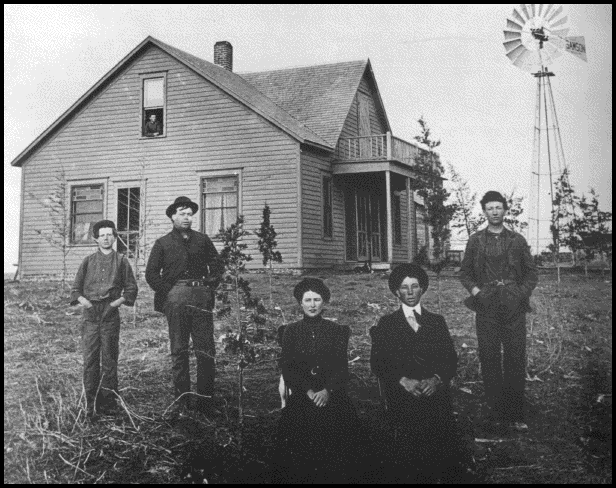
American
Windmills
An Album of
Historic Photographs
T. Lindsay Baker
(University of Oklahoma)

If you ever saw "Days of Heaven" --- that heavenly movie about the northern Great Plains --- the most characteristic noises of that flat country were the trains, and the wind, and the wind making the windmills creak and sigh. Windmills, as the author reminds us, were omnipresent, either to pump water from underground, or to mill wheat, rye, oats, or any other grains.
It's the essence of solitary, isolated, inward-looking, turn-of-the-century American life, this sentinel hovering at the edge of the horizon, arms moving slowly, counting the winds, as it were. And, as you got closer, you would hear that mournful soughing, the wind passing through the great hands, moving the blades around and around and around. A sweet, sad sign out of our solemn pasts.
There are, in American Windmills, almost 200 black-and-white photographs of these sentinels of the continent, some from the late nineteenth century, some from as late as the 1950s.
As photograph collector John Carter explains, in his windy introduction --- complete with the word "ontologically" offered up not once but three times --- if you passed through the Great Plains a hundred years ago, the most obvious structure would be either a church steeple or a windmill. Or, we might suppose, what they called the hangman's "cradle." The names of the manufacturers were displayed on the single back blade behind the windmill, one that kept it oriented towards the wind: Star Mill, Standard, Plymouth Iron, Atlanta Wind Engine, Wonder, Kregel, Challenge, Dempster, Sampson. For free Sears would paint in the name of the owner of the windmill for all to see.
Families would gather to be photographed outside the house (often a sod hut), with horses and cows and the windmill --- for, the author surmises, the pumping mechanism might have been the most expensive item on the farm. Some of the structures are shown here in disarray, fallen, blasted apart, for the constant winds that blew often blew too hard.
There are some homemade structures, eccentric, a few artistic, one made from barrels split down the middle and welded onto the rotators. There are the multiple displays of many windmills, gathered together temporarily like foolish giants for the annual County Fair. A dozen or so were erected in Griswold, Iowa for a fish farm. Oliver Parker Fritchle combined a windmill with a dynamo to power a house at Warminster, Colorado, and painted "Fritchle Wind-Electric Light" on the guiding tail.
This is a fine book for those of us who are nostalgically (perhaps neurotically) attached to America's robust experiments in living from a century back. We could only wish that the author had taken the time to explain how the hell a windmill actually pumps water. We can see how a simple gear system with grinding stones would make a fine mill for corn. We can imagine the use of a dynamo in the revolving head for electricity. But we still cannot figure out how this armed monster --- one whose waving arms would send a Don Quixote raging into battle --- can transform a vertical rotary motion into one that can lift liquids from the depths.
--- Gale Resmond